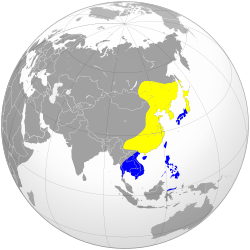| Image | Scientific name | Common name | Distribution |
|---|
 | Botaurus stellaris | Eurasian bittern | 
Europe and Asia from the British Isles, Sweden and Finland eastwards to Sakhalin Island in eastern Siberia and Hokkaido Island in Japan |
 | Botaurus poiciloptilus | Australasian bittern | 
Australia, Tasmania, New Zealand, New Caledonia and Ouvea |
 | Botaurus lentiginosus | American bittern | 
the U.S. Gulf Coast states, all of Florida into the Everglades, the Caribbean islands and parts of Central America |
 | Botaurus pinnatus | Pinnated bittern or South American bittern | 
Mexico to northern Argentina, though there are few records for Guatemala and Honduras |
 | Botaurus involucris (formerly placed in Ixobrychus) | Stripe-backed bittern | 
Colombia, Venezuela, Guyana, Suriname, French Guiana and the island of Trinidad, and in Paraguay, Uruguay, Argentina, Chile and Brazil |
 | Botaurus exilis (formerly placed in Ixobrychus) | Least bittern | 
southern Canada to northern Argentina |
 | Botaurus flavicollis (formerly placed in Ixobrychus) | Black bittern | 
tropical Asia from Pakistan, India, Bangladesh and Sri Lanka east to China, Indonesia, and Australia |
 | Botaurus cinnamomeus (formerly placed in Ixobrychus) | Cinnamon bittern | 
tropical and subtropical Asia from India east to China and Indonesia |
 | Botaurus eurhythmus (formerly placed in Ixobrychus) | Von Schrenck's bittern | 
Indonesia, the Philippines, Singapore, Laos, China and Siberia |
 | Botaurus sturmii (formerly placed in Ixobrychus) | Dwarf bittern | 
Angola, Benin, Botswana, Burkina Faso, Burundi, Cameroon, Central African Republic, Chad, Republic of the Congo, Democratic Republic of the Congo, Ivory Coast, Equatorial Guinea, Eswatini, Ethiopia, Gabon, Gambia, Ghana, Guinea, Kenya, Liberia, Malawi, Mali, Mauritania, Mozambique, Namibia, Niger, Nigeria, Rwanda, Senegal, Sierra Leone, Somalia, South Africa, Spain (the Canary Islands), Sudan, Tanzania, Togo, Uganda, Zambia, and Zimbabwe |
 | Botaurus minutus (formerly placed in Ixobrychus) | Little bittern | 
Africa, central and southern Europe, western and southern Asia, and Madagascar |
 | Botaurus sinensis (formerly placed in Ixobrychus) | Yellow bittern | 
northern Indian Subcontinent, east to the Russian Far East, Japan and Indonesia. |
 | Botaurus dubius (formerly placed in Ixobrychus) | Black-backed bittern | 
Australia and southern New Guinea |
|




























